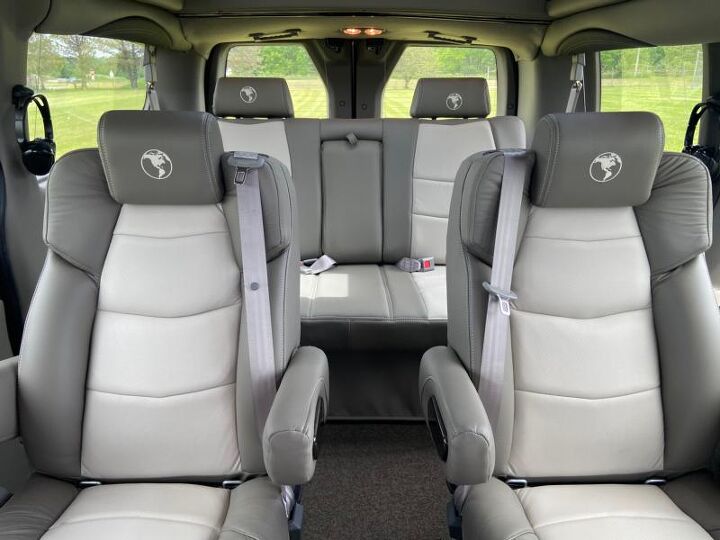Rare Rides: Luxury Van Time With a 2017 Ford Transit Explorer Conversion

Today’s Rare Ride was sort of off the radar as a present day vehicular category until your author was presented with one in an ad. It’s the sort of luxurious conversion van people bought to take their grandkids on vacation in the Nineties and early 2000s, but updated for today.
Presenting the Ford Transit Explorer Conversion. It’s quite large.
The Transit name is a longstanding one in Europe and places not North America, where it’s been on sale as a cargo hauler since 1965. The van entered its fourth generation in 2013 and debuted at NAIAS that year. Unlike other Transit generations which were Europe-centric, this generation was designed jointly by Ford teams in North America and Europe. The Transit entered North America as a replacement for the absolutely ancient E-Series van (still produced today in stripped chassis version). Transit went on sale as a 2015 model in North America.
Available in cutaway, chassis, cargo, and passenger versions, the Transit’s flexible platform is rear-wheel drive or all-wheel drive, and front-wheel drive in some markets. The front- and rear- drivetrain optionality appeared for the first time on the third-generation Transit in 2000 (still in production for select Asian markets).
The Transit is presently available in cargo and passenger guise as standard 129.9-inch wheelbase, as well as a longer 147.6-inch version called the 150. Roof heights also vary, separated as low, medium, and high. Cab and cutaway versions have their own short, regular, and long wheelbases as well. A variety of small inline-four engines are available globally, but American versions have a 3.7-liter V6 (275hp) as standard, with a 3.5-liter EcoBoost V6 (310hp) an optional extra.
Explorer conversions offer seven- and nine-passenger luxury versions of the Transit 150 as well as a Factory Medium Roof version of the Transit 250. All Explorer Transits have the EcoBoost engine, and all-wheel drive is optional on all models.
Today’s Rare Ride is a nine-passenger low roof version, to which Explorer fitted a luxurious two-tone brown interior. Leather and wood are almost everywhere you’d expect in a conversion van, along with the curtains and interior roof lighting. The extended roof also contains a large TV, a rear sunroof, and transom windows along both sides. It’s pretty far removed from a standard Transit passenger van, and that shows in the price. While our used 2017 example is $43,900, a new one will cost around $80,000. Here’s betting this is a much better vehicle than an old Econoline or Express conversion.
[Images: Explorer Conversions]

Interested in lots of cars and their various historical contexts. Started writing articles for TTAC in late 2016, when my first posts were QOTDs. From there I started a few new series like Rare Rides, Buy/Drive/Burn, Abandoned History, and most recently Rare Rides Icons. Operating from a home base in Cincinnati, Ohio, a relative auto journalist dead zone. Many of my articles are prompted by something I'll see on social media that sparks my interest and causes me to research. Finding articles and information from the early days of the internet and beyond that covers the little details lost to time: trim packages, color and wheel choices, interior fabrics. Beyond those, I'm fascinated by automotive industry experiments, both failures and successes. Lately I've taken an interest in AI, and generating "what if" type images for car models long dead. Reincarnating a modern Toyota Paseo, Lincoln Mark IX, or Isuzu Trooper through a text prompt is fun. Fun to post them on Twitter too, and watch people overreact. To that end, the social media I use most is Twitter, @CoreyLewis86. I also contribute pieces for Forbes Wheels and Forbes Home.
More by Corey Lewis
Latest Car Reviews
Read moreLatest Product Reviews
Read moreRecent Comments
- El Kevarino There are already cheap EV's available. They're called "used cars". You can get a lightly used Kia Niro EV, which is a perfectly functional hatchback with lots of features, 230mi of range, and real buttons for around $20k. It won't solve the charging infrastructure problem, but if you can charge at home or work it can get you from A to B with a very low cost per mile.
- Kjhkjlhkjhkljh kljhjkhjklhkjh haaaaaaaaaaahahahahahahahaha
- Kjhkjlhkjhkljh kljhjkhjklhkjh *Why would anyone buy this* when the 2025 RamCharger is right around the corner, *faster* with vastly *better mpg* and stupid amounts of torque using a proven engine layout and motivation drive in use since 1920.
- Kjhkjlhkjhkljh kljhjkhjklhkjh I hate this soooooooo much. but the 2025 RAMCHARGER is the CORRECT bridge for people to go electric. I hate dodge (thanks for making me buy 2 replacement 46RH's) .. but the ramcharger's electric drive layout is *vastly* superior to a full electric car in dense populous areas where charging is difficult and where moron luddite science hating trumpers sabotage charges or block them.If Toyota had a tundra in the same config i'd plop 75k cash down today and burn my pos chevy in the dealer parking lot
- Kjhkjlhkjhkljh kljhjkhjklhkjh I own my house 100% paid for at age 52. the answer is still NO.-28k (realistically) would take 8 years to offset my gas truck even with its constant repair bills (thanks chevy)-Still takes too long to charge UNTIL solidsate batteries are a thing and 80% in 15 minutes becomes a reality (for ME anyways, i get others are willing to wait)For the rest of the market, especially people in dense cityscape, apartments dens rentals it just isnt feasible yet IMO.






































Comments
Join the conversation
Possibly relevant (probably not): https://www.amazon.com/Vannin-Terry-Cook/dp/B00ZDBJY2Q https://www.hulu.com/movie/nomadland
Little late to this one, but that’s a heckuva nice looking ride! My Dad and I rented one of the regular-length cargo versions to move the furniture out of my grandmother’s room at her assisted-living facility after she passed, and he was impressed with the pickup. He didn’t believe me when I said that it had a turbo V6 under the bonnet! It was reasonably comfortable, as well.